|
|
|
|
|
Oil On
Canvas, Real Flavor of Old Masters
|
|

|
ARTWORKS
INDEX
A B C D E F G H I J K L M N O P Q R S T U V W X Y Z |
ARTISTS
INDEX
A B C D E F G H I J K L M N O P Q R S T U V W X Y Z |
|
|
| | |
|
|
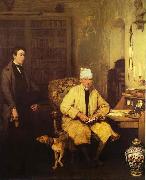 |
Sir David Wilkie -- Click Here
|
|
1785-1841
British Sir David Wilkie Galleries
Wilkie may have inherited his rectitude and tenacity, even his nervous inhibitions, from his father, the minister of his native parish. Though little responsive to schooling, he showed an early inclination towards mimicry that expressed itself in drawings, chiefly of human activity. In these he was influenced by a copy of Allan Ramsay pastoral comedy in verse, the Gentle Shepherd (1725), illustrated by David Allan in 1788. One of the few surviving examples of his early drawings represents a scene from it (c. 1797; Kirkcaldy, Fife, Mus. A.G.). Wilkie cherished the demotic spirit of this book and its illustrations throughout his life. |
|
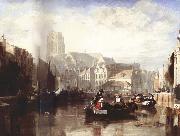 |
Sir Augustus Wall Callcott -- Click Here
|
|
1779-1844
|
|
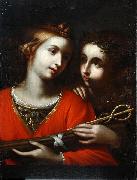 |
Simone Pignoni -- Click Here
|
|
Simone Pignoni (April 17, 1611 - December 16, 1698) was an Italian painter of the Baroque period.
He apprenticed with Fabrizio Boschi, then with the more academic and puritanical Domenico Passignano, and finally with Francesco Furini. He is best known for painting in a style reminiscent of the morbidly sensual Furini. Reflective of this obsession is his self-portrait, c. 1650, in which he depicts himself building up a plump naked female from a skeleton. The biographer Baldinucci, in what little he notes of the painter, recalls him as the scandalous imitator of (Furini's) licentious inventions.
A more complete biography was recorded by his pupil Giovanni Camillo Sagrestani. Described as endowed with a bizarre and amenable intelligence, Pignoni apparently had a late-life conversion to more pious painting. There is one episode recalled that during a serious illness because in his life he had focused on studying about female forms, and (now) having resigned himself to the impending infinity, his spiritual father urged him to purge those errors with the flame, and once guided by a good disposition, he suddenly was cured by the Lord. It must be noted that Baldinucci's biography of Furini, also recorded a similar, near-death renunciation of his art of the naked figure.
Among his more conventional works are a St. Agatha cured by St. Peter (attributed) in the Museo Civico di Trieste. A St. Louis providing a banquet for the poor (c. 1682) now in the church of Santa Felicita in Florence, commissioned by Conte Luigi Gucciardini. A Madonna and child in glory with archangels Saints Michael and Raphael in battle armor and San Antonio of Padua (1671) for the Cappella di San Michele in Santissima Annunziata. He painted an Allegory of Peace in Palazzo Vecchio. A Penitent Magdalen has been attributed to Pignoni is found in the Pitti Palace. In San Bartolomeo in Monteoliveto, he painted a Madonna appearing to Blessed Bernardo Tolomeo.
|
|
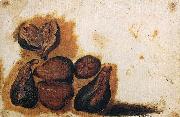 |
Simone Peterzano -- Click Here
|
|
(c. 1540 - c. 1596) was an Italian painter of the later Mannerism, native of Bergamo. He is mostly known as the master of Caravaggio.
He was a pupil of Titian in Venice, Peterzano debuted in Milan with the counterfaçade frescoes in San Maurizio al Monastero Maggiore (1573), influenced by Veronese and Tintoretto. In the same year he painted two canvasses with Histories of Sts. Paul and Barnabas for the church of San Barnaba, also in Milan. Also from the same period are a Piete in the church of San Fedele and a Pentecost for San Paolo Converso (now in Sant'Eufemia).
Between 1578 and 1582 Peterzano executed frescoes in the presbytery of Garegnano Charterhouse, considered one of his masterworks. His last works, characterized by a cold monumental style, include a fresco with Stories of St. Anthony of Padua for the church of Sant'Angelo, a canvas with Madonna with Child and Saints for the parish church of Bioggio (Canton Ticino) and an altarpiece with St. Ambrose between Sts. Gervasius and Protasius in the Duomo of Milan (1592, now in the Pinacoteca Ambrosiana).
|
|
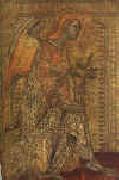 |
Simone Martini -- Click Here
|
|
1283-1344
Italian
Simone Martini Locations
He was a major figure in the development of early Italian painting and greatly influenced the development of the International Gothic style. It is thought that Martini was a pupil of Duccio di Buoninsegna, the leading Sienese painter of his time. His brother-in-law was the artist Lippo Memmi. Very little documentation survives regarding Simone's life, and many attributions are debated by art historians. Simone Martini died while in the service of the Papal court at Avignon in 1344.
Simone was doubtlessly apprenticed from an early age, as would have been the normal practice. Among his first documented works is the Maest?? of 1315 in the Palazzo Pubblico in Siena. A copy of the work, executed shortly thereafter by Lippo Memmi in San Gimignano, testifies to the enduring influence Simone's prototypes would have on other artists throughout the fourteenth century. Perpetuating the Sienese tradition, Simone's style contrasted with the sobriety and monumentality of Florentine art, and is noted for its soft, stylized, decorative features, sinuosity of line, and unsurpassed courtly elegance. Simone's art owes much to French manuscript illumination and ivory carving: examples of such art were brought to Siena in the fourteenth century by means of the Via Francigena, a main pilgrimage and trade route from Northern Europe to Rome.
Simone's major works include the Maest?? (1315) in the Palazzo Pubblico in Siena, St Louis of Toulouse Crowning the King at the Museo di Capodimonte in Naples (1317), the S. Caterina Polyptych in Pisa (1319) and the Annunciation and two Saints at the Uffizi in Florence (1333), as well as frescoes in the Chapel of St. Martin in the lower church of the Basilica of San Francesco d'Assisi. Francis Petrarch became friend with Simone while in Avignon, and two of his sonnets make reference to a portrait of Laura de Noves he supposedly painted for the poet.
|
|
 |
Simone Dei Crocifissi -- Click Here
|
|
Italian Painter , 1330-1399 |
|
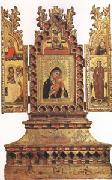 |
Simone Dei Crocefissi -- Click Here
|
|
Fourteenth century
Fourteenth century.Italian painter. He was the son of a Bolognese cobbler and was almost certainly the pupil of Jacopo di Scannabecchi di Dalmasio, who married his sister in 1350. Simone was already a master painter when first recorded in 1355, probably living opposite S Domenico, Bologna, |
|
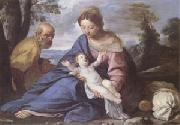 |
Simone Cantarini,Called Il Pesarese -- Click Here
|
|
Pesaro 1612-Bologna 1648 |
|
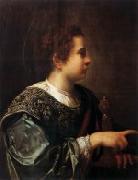 |
Simon Vouet -- Click Here
|
|
b. 1590, Paris, d. 1649, Paris.French painter and draughtsman. Although at the time regarded as one of the leading French painters of the first half of the 17th century, he is now known more for his influence on French painting than for his actual oeuvre. He made his reputation in Italy, where he executed numerous portraits for aristocratic patrons and was commissioned for religious subjects. Although the early Italian works show the influence of Caravaggio, his work was subsequently modified by the Baroque style of such painters as Lanfranco and the influence of the Venetian use of light and colour. |
|
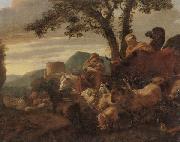 |
Simon van der Does -- Click Here
|
|
Dutch , Amsterdam circa 1653-after 1718
|
|
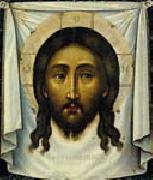 |
Simon Ushakov -- Click Here
|
|
1626 - 1686) was a leading Russian graphic artist of the late 17th-century. Together with Fyodor Zubov and Fyodor Rozhnov, he is associated with the comprehensive reform of the Russian Orthodox Church undertaken by Patriarch Nikon.
We know almost nothing about the early years of Simon Ushakov. His birth date is deduced from his inscription on one of the icons: In the year 7166 painted this icon Simon Ushakov son, being 32 years of age.
At 22 he became a paid artist of the Silver Chamber, affiliated with the Armory Prikaz. The bright, fresh colours and exquisite, curving lines of his proto-baroque icons caught the eye of Patriarch Nikon, who introduced Simon to the tsar Alexei Mikhailovich. He became a great favourite with the royal family and was eventually (1664) assigned to the Kremlin Armoury, run by an educated boyar Bogdan Khitrovo. |
|
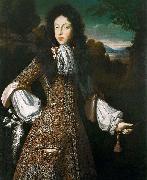 |
Simon Pietersz Verelst -- Click Here
|
|
(1644, The Hague - 1710, London), was a Dutch Golden Age painter.
According to the RKD he was the son of Pieter Harmensz Verelst and became a pupil in the Confrerie Pictura at the same time as his brother Herman in 1663. In 1668 he moved to London and called himself "the God of Flowers", but is known for portraits as well as flower and fruit still life paintings. |
|
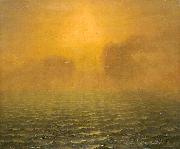 |
Simon Mathurin Lantara -- Click Here
|
|
(24 March 1729 - 22 December 1778) was a French landscape painter.
He was born at Oncy. His father was a weaver, and he himself began life as a herdboy; but, having attracted the notice of Gille de Reumont, a son of his master, he was placed under a painter at Versailles. Endowed with great facility and real talent, his powers found ready recognition; but he found the constraint of a regular life and the society of educated people unbearably tiresome; and as long as the proceeds of the last sale lasted he lived careless of the future in the company of obscure workmen. Rich amateurs more than once attracted him to their houses, only to find that in ease and high living Lantara could produce nothing. He died in Paris in 1778.
His works, now much prized, are not numerous; the Louvre has one landscape, Morning, signed and dated 1761. Émile Bernard, Joseph Vernet, and others are said to have added figures to his landscapes and sea-pieces. Engravings after Lantara will be found in the works of Lebas, Piquenot, Duret, Mouchy and others. In 1809 a comedy called Lantara, or the Painter in the Pothouse, was brought out at the Vaudeville with great success.
|
|
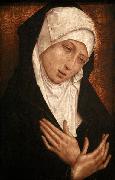 |
Simon Marmion -- Click Here
|
|
(born c. 1425 at Amiens, France, died 24 or 25 December 1489, Valenciennes) was a French or Burgundian Early Netherlandish painter of panels and illuminated manuscripts. Marmion lived and worked in what is now France but for most of his lifetime was part of the Duchy of Burgundy in the Southern Netherlands.
Like many painters of his era, Marmion came from a family of artists, and both his father, Jean, and his brother Mille were painters. Marmion is recorded as working at Amiens between 1449 to 1454, and then at Valenciennes from 1458 until his death. He was patronized by Philip the Good, the Duke of Burgundy from 1454 when he was one of several artists called to Lille to work on the decorations for the Feast of the Pheasant. He was employed by several members of the ducal family, including Charles the Bold and Margaret of York. He was called "the prince of illuminators" by a near contemporary. Three years after his death his widow, Jeanne de Quaroube, married his pupil, the painter Jan Provoost, who on her death inherited the considerable Marmion estate.
Although best known for his illuminated manuscripts, Marmion also produced portraits and other paintings, altarpieces, and decorative work. A famous double-sided altarpiece with several Scenes from the life of St Bertin is in the Gemäldegalerie, Berlin (with two sections in the National Gallery (London). There is a Mass of Saint Gregory in Toronto, and a Lamentation of Christ in the Metropolitan Museum of Art,three works in Philadelphia, and several others elsewhere. Stylistically he lies between his French and Flemish contemporaries, with a Flemish innovation in composition and landscape. His perspective is usually technically sound, but the proportions of his figures are often awkward, and their poses rather stiff.
|
|
|
|
|
|
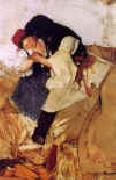 |
Simon Hollosy -- Click Here
|
|
1857-1918
Hungarian Simon Hollosy Gallery
Simon Hollosy (Romanian: Simion Corbu); (2 February 1857, Maramarossziget, now Sighetu Marmatiei - 8 May 1918, Tecso, now Tiachiv) was a Hungarian painter. He was considered one of the greatest Hungarian representatives of 19th century Naturalism and Realism.
Holl??sy came from an Armenian family who settled in Maramarossziget (present-day Sighetu Marmaţiei, Romania). He frequently worked abroad.
He criticized training at the Academy and founded a private school in 1886 where he gathered young talents around him who were interested in realistic protrayal. He opened the way to new styles by relying on his personality and by pointing out the merits of French pictures (Courbet) exhibited in Munich. He abandoned the academic style in order to follow new trends in French painting.
Encouraged by Istvan Reti and Janos Thorma, his pupils and friends, he spent the summer of 1896 in Nagyb??nya (present-day Baia Mare, Romania) with his school, which played an important role in Hungarian painting as the cradle of the Nagybanya school. He soon settled down in Nagybanya. With its style (sunny landscapes), his school determined Hungarian painting for decades. Leaving the Nagyb??nya colony in 1901, he spent the summers in Tecso with his students from 1902. During winters he was in Munich to run his school there.
He was not productive as an artist: he was in search of atmospheres and his productivity was confined to teaching. His large scale plan of "Rakoczi March" with a lot of figures got as far sketches because he kept on changing his mind. The landscapes painted in Tecso include "Landscape in T??cső", "Landscape with Stacks and Sunset with Stacks", where he applied elements of plein air and impressionism.
His self-portrait (1916) is one of his most harrowing pictures. |
|
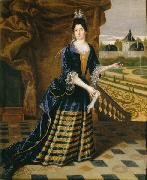 |
Simon Dequoy -- Click Here
|
|
Simon Dequoy (1655-1727)
|
|
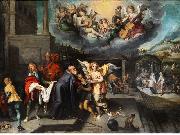 |
Simon de Vos -- Click Here
|
|
Simon de Vos (Antwerp, 20 October 1603-15 October 1676, Antwerp) was a Flemish Baroque painter of genre and cabinet pictures.
De Vos studied with Cornelis de Vos (1603-76), to whom he is not related, from 1615 until 1620. In 1620 he joined Antwerp's guild of St. Luke, and then he probably travelled to Rome where he came under the influence of the "low-life" genre paintings of the Bentvueghels and the bambocciate. A Caravaggesque influence, by way of the German painter Johann Liss active in Italy during the 1620s is discernible in De Vos's paintings from this time on. In contrast to the earlier "low-life" paintings, works from the late 1620s until around 1640, which were made after returning to Antwerp, are mostly small "merry company" and courtly genre scenes reminiscent of contemporary Dutch painters Dirck Hals and Pieter Codde. After 1640, De Vos turned away from genre scenes altogether and painted mostly small cabinet paintings of history subjects, influenced stylistically at first by Peter Paul Rubens and then increasingly by Anthony van Dyck. Examples include The Beheading of St. Paul (1648) in the Royal Museum of Fine Arts, Antwerp.
He married Catharina van Utrecht, the sister of Adriaen van Utrecht, in 1628. |
|
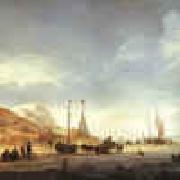 |
Simon de Vlieger -- Click Here
|
|
Dutch
1600-1653
Dutch painter, draughtsman, etcher and stained-glass designer. He was one of the leading marine and landscape artists of the Dutch school and decisively influenced the direction of Dutch marine art during the 1630s and 1640s. His late works anticipated the shift from the monochrome or tonal phase of Dutch marine art to the more classical style of Jan van de Cappelle and Willem van de Velde the younger (see MARINE PAINTING). Although de Vlieger reputation rests chiefly on his marine paintings, he was also a notable draughtsman and etcher.
|
|
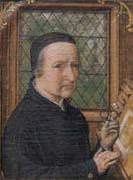 |
Simon Bening -- Click Here
|
|
Flemish Northern Renaissance Manuscript Illuminator, ca.1483-1561
was a 16th century miniature painter of the Ghent-Bruges school, the last major artist of the Netherlandish tradition. Bening was trained in his father Alexander Bening's miniature painting workshop in Ghent. He made his own name after moving to Bruges. His specialty was the book of hours, but by his time these were becoming relatively unfashionable, and only produced for royalty and the very rich. He also created genealogical tables and portable altarpieces on parchment. Many of his finest works are Labours of the Months for Books of Hours which are largely small scale landscapes, at that time a nascent genre of painting. In other respects his style is relatively little developed beyond that of the years before his birth, but his landscapes serve as a link between the 15th century illuminators and Peter Brueghel. His self-portrait and other portraits equally are early examples of the portrait miniature. He served as dean of the calligraphers, booksellers, illuminators, and bookbinders in the Guild of Saint John and Saint Luke. He created books for German rulers, like Cardinal Albrecht of Brandenburg, and royalty like Emperor Charles V and Don Fernando, the Infante of Portugal. The artistic tradition continued in his family. His eldest daughter, Levina Teerlinc |
|
 |
Simon Vouet -- Click Here
|
|
French
Simon Vouet Gallery
1590-1649
French painter and draughtsman. Although at the time regarded as one of the leading French painters of the first half of the 17th century, he is now known more for his influence on French painting than for his actual oeuvre. He made his reputation in Italy, where he executed numerous portraits for aristocratic patrons and was commissioned for religious subjects. Although the early Italian works show the influence of Caravaggio, his work was subsequently modified by the Baroque style of such painters as Lanfranco and the influence of the Venetian use of light and colour. When he was summoned back to France by Louis XIII in 1627 he thus brought with him an Italian idiom hitherto unknown in France that revitalized French painting.
|
|
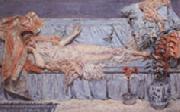 |
Simeon Solomon -- Click Here
|
|
English Pre-Raphaelite Painter, 1840-1905
was an English Pre-Raphaelite painter. Solomon was born into a prominent Jewish family. He was the eighth and last child born to merchant Michael (Meyer) Solomon and artist Catherine (Kate) Levy. Solomon was a younger brother to fellow painters Abraham Solomon (1824?C1862) and Rebecca Solomon (1832?C1886). Born and educated in London, Solomon started receiving lessons in painting from his older brother around 1850. He started attending Carey's Art Academy in 1852. His older sister first exhibited her works at the Royal Academy during the same year. As a student at the Royal Academy Schools, Solomon was introduced through Dante Gabriel Rossetti to other members of the Pre-Raphaelite circle, including the poet Algernon Charles Swinburne and the painter Edward Burne-Jones in 1857. His first exhibition was at the Royal Academy in 1858. He continued to hold exhibitions of his work at the Royal Academy between 1858 and 1872. In addition to the literary paintings favoured by the Pre-Raphaelite school, Solomon's subjects often included scenes from the Hebrew Bible and genre paintings depicting Jewish life and rituals. Solomon lived as an openly gay man in a time when it was not socially acceptable to do so,[1] but in 1873 his career was cut short when he was arrested in a public urinal at Stratford Place Mews, off Oxford Street, in London and charged with indecent exposure and attempting to commit sodomy. He was sentenced to serve eighteen months' hard labour in prison, but this was later reduced to police supervision. He was arrested again in 1874 in Paris, after which he was sentenced to spend three months in prison. In 1884 he was admitted to the workhouse where he continued to produce work; however, his life and talent were blighted by alcoholism. Twenty years later in 1905, he died from complications brought on by his alcoholism. He was buried at the Jewish Cemetery in Willesden. |
|
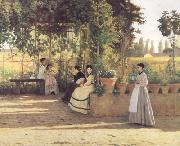 |
Silvestro lega -- Click Here
|
|
Italian Realist Painter, 1826-1895
Italian painter. From 1843 to 1847 he attended the Accademia di Belle Arti, Florence, studying drawing under Benedetto Servolini (1805-79) and Tommaso Gazzarini (1790-1853), then, briefly, painting under Giuseppe Bezzuoli. About 1847 he entered Luigi Mussini's school (see PURISMO), where the teaching emphasized the 15th-century Florentine principles of drawing and orderly construction. Then and for some years afterwards he continued to attend the Scuola del Nudo of the Accademia. After fighting in the military campaigns for Italian independence (1848-9) Lega resumed his training, this time under Antonio Ciseri, executing his first large-scale painting, Doubting Thomas (1850; Modigliana, Osp. Civ.). In 1852 he won the Concorso Trienniale dell'Accademia with David Placating Saul |
|
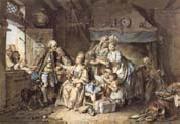 |
Sigmund Freudenberger -- Click Here
|
|
Swiss, 1745-1801,Swiss painter, draughtsman and engraver. In 1761 he went to work for the portrait painter Emanuel Handmann in Basle, where he stayed for three years. In 1765, with Adrian Zingg (1734-86), he left for Paris, where he trained with Jakob Schmutzer (1733-1811) and frequented the studio of Jean Georges Wille, the celebrated engraver. He worked as a book illustrator during this period. The work of Boucher, whom he met, and of Greuze and Fragonard had a significant influence on his artistic development. Freudenberger returned in 1773 to Berne, where he undertook several portraits. He became friendly with Johann Ludwig Aberli, with whom he travelled the countryside, which he recorded in numerous drawings, watercolours and engravings. He specialized in genre scenes, rustic still-lifes and portrayals of Bernese peasant life, which became very popular. In some works, such as a red chalk drawing of A Woman Playing the Harp (1778; Zurich, Schweizer. Landesmus.), he continued the gallant style he had learnt from Boucher. His watercolours were frequently engraved, either individually or in series, and hand-coloured. His style is characterized by detailed and careful execution and by an intimate, narrative approach, although he tended to idealize his rustic subject-matter. His work was significant in introducing genre subjects in Switzerland, where artists had tended to concentrate on pure landscape. He ran a large studio where Daniel Lafond (1763-1831), Niklaus Kenig and Georg Mind (1768-1814) were pupils. The French Revolution was disastrous for his art and his business and clouded the last years of his life. |
|
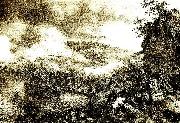 |
sigismund vasa -- Click Here
|
|
1566-1632, vars rattmatiga dynastiska krav pa den svenska tronen gjorde honom till en livslang fiende med kusinen gustav ll adolf. |
|
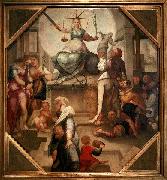 |
Sienese school -- Click Here
|
|
The Sienese School of painting flourished in Siena, Italy between the 13th and 15th centuries and for a time rivaled Florence, though it was more conservative, being inclined towards the decorative beauty and elegant grace of late Gothic art. Its most important representatives include Duccio, whose work shows Byzantine influence; his pupil Simone Martini; Pietro and Ambrogio Lorenzetti; Domenico and Taddeo di Bartolo; Sassetta and Matteo di Giovanni. Unlike the naturalistic Florentine art, there is a mystical streak in Sienese art, characterized by a common focus on miraculous events, with less attention to proportions, distortions of time and place, and often dreamlike coloration. In the 16th century the Mannerists Beccafumi and Il Sodoma worked there. While Baldassare Peruzzi was born and trained in Siena, his major works and style reflect his long career in Rome. The economic and political decline of Siena by the 16th century, and its eventual subjugation by Florence, largely checked the development of Sienese painting, although it also meant that a good proportion of Sienese works in churches and public buildings were not discarded or destroyed by new paintings or rebuilding. Siena remains a remarkably well-preserved Italian late-Medieval town.
|
|
|
|
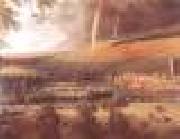 |
SIBERECHTS, Jan -- Click Here
|
|
Flemish Baroque Era Painter, 1627-1703
Flemish painter, active in England. He was the son of the sculptor of the same name and became a master in the Guild of St Luke in Antwerp by 1648. He married in 1652 and moved to England sometime between 1672 and 1674. |
|
|
|
 |
Shaykh Muhammad -- Click Here
|
|
the period of 1465-1535
|
|
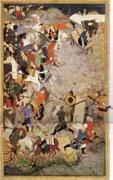 |
Sharafuddin Yazdi -- Click Here
|
|
the period of 1465-1535
|
|
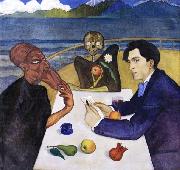 |
Shalva Kikodze -- Click Here
|
|
Shalva Kikodze (Georgian: შალვა ქიქოძე) (1894 - 1921) was a Georgian expressionist painter, graphic artist and theatre decorator. Together with Lado Gudiashvili and David Kakabadze, he is considered a key figure in Georgian art of the early 20th century.
He was born in a remote Georgian village Bakhvi, Guria, then part of the Russian Empire. From 1914 to 1918, he studied at Moscow School of Painting, Sculpture and Architecture. In 1916, he took part in an expedition to the Georgian village Nabakhtevi and made copies of the 15th-century murals from the local church. He stayed in his motherland for a short period of 1918-1920, and worked chiefly as a theater decorator for Jabadari Theater in Tbilisi. Afterwards he moved to Paris, where he, together with his fellow painters, Gudiashvili and Kakabadze, held an exhibition in 1921. He died in Freiburg, Germany, on November 7, 1921
|
|
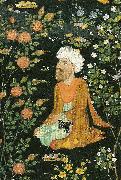 |
shah-u-gada -- Click Here
|
|
In Vishnudharmottara Purana, Kubera is described as the embodiment of both Artha ("wealth, prosperity, glory") and Arthashastras, treatises related to it and his iconography mirrors it. Kubera's complexion is described as that of lotus leaves. He rides a man - the state personified, adorned in golden clothes and ornaments, symbolizing his wealth. His left eye is yellow. He wears a armour and necklace upto his large belly. His face should be inclined to the left, sporting a beard and moustache and with two small tusks protruding from the ends of his mouth, representing his powers to punish and bestow favours. His wife Riddhi - representing the journey of life - is seated on his left lap, with her left hand on the back of Kubera and right holding a ratna-patra ("jewel-pot"). He should be four-armed, holding a gada (mace - symbol of dandaniti - administration of justice) and a shakti (power) in his left pair and standards bearing a lion - representing artha and a shibika (a club, the weapon of Kubera). The nidhi treasures Padma and Shankha stand besides him in human forms with their heads emerging from a lotus and a conch respectively. Agni Purana states that Kubera should be installed in temples as seated on a goat with club in his hand. Kubera's image is prescribed to be of gold with multi-coloured attributes |
|
|
|
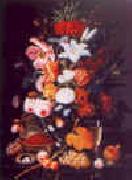 |
Severin Roesen -- Click Here
|
|
1848-1871
Severin Roesen (ca. 1815-1872) is a painter known for his abundant fruit and flower still lifes and is today recognized as one of the major American still-life painters of the mid-nineteenth century. Born in Cologne, in Germany, he emigrated to the United States in 1848.
While Roesen's paintings reveal a meticulous attention to detail in their precise arrangements and close brushwork, his subject matter, even down to specific motifs, did not change throughout his career. Sometimes he made near copies of paintings, but usually he merely rearranged and reassembled stock elements.
Numerous items in Fruit and Wine Glass, for example, also appear in other paintings. The footed desert plate full of strawberries is a common motif. The pilsner glass, sometimes accompanied by an open bottle of champagne, is interchangeable with a wine goblet filled with lemonade used elsewhere. The glass is nearly always placed at the lower left edge of the painting; a halved lemon often appears nearby. Branches full of grapes arranged from lower left to upper right provide the composition with a graceful S-curve and subtly lead the viewer's eye over the entire display. Here the composition is balanced by light and dark grapes at either side and filled in by scattered raspberries, cherries, peaches, apples, pears, and apricots. Many of these compositional elements, if not the items depicted, were derived from seventeenth-century Dutch still life paintings by such artists as Jan van Huysem. |
|
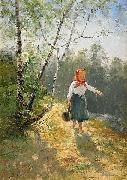 |
Severin Nilsson -- Click Here
|
|
(1846 - 1918) was a Swedish painter and photographer.
He was born in Halland in the south of Sweden. He studied at the Royal Swedish Academy of Arts in Stockholm 1865 - 1871 and then under Leon Bonnat in Paris for three years.
Severin painted portraits, landscapes and genre pictures. A prolific artist, he participated in numerous exhibitions and left behind a large and diverse production of work. He was also one of the first Swedish documentary photographers. Inspired by Arthur Hazelius, he made photographic studies of public life, especially in the village Asige in Halland, where he was born
|
|
|
|
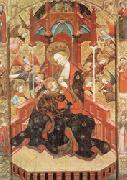 |
SERRA, Pedro -- Click Here
|
|
Spanish painter
active 1363-1399 |
|
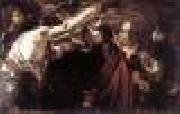 |
SERODINE, Giovanni -- Click Here
|
|
Italian Baroque Era Painter, 1600-1630
Italian painter and stuccoist. His family moved from Ascona on Lake Maggiore to Rome, where his father is recorded in 1595. It is probable that Serodine was born there. His first work was probably done in association with his brother Giovanni Battista Serodine (1589/90-1630), a stuccoist active in Rome, where he carved a Virgin and Child (1614) for the fa?ade of S Francesca Romana, and in Ascona, where he restored the family home and decorated it with stucco (1620). The design and stucco decoration of the church of the Madonna della Fortuna on Monte Verit? (Ascona) are attributed to him, though it is probable that Giovanni (who is recorded in Ascona in 1620) collaborated in the work. The first of Giovanni's documented official commissions, however, was for the stucco decoration and apsidal paintings in the chuch of the Concezione at Spoleto, where he worked with Sante Ghezzi (Corradini; Toscano). These murals, painted in tempera and completed in July 1624, are sketchy and clumsily executed, quite distinct in their inferior quality and naive piety from the rest of Serodine's work. They are probably his first attempts at painting, |
|
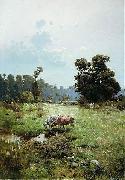 |
Serhii Vasylkivsky -- Click Here
|
|
(October 19, 1854, Izium e October 7, 1917, Kharkiv) was one of the most prolific Ukrainian artists of the pre-revolutionary period and an expert on Ukrainian ornamentation and folk art.
Vasylkivsky grew up in an environment conducive to his development as an artist. He was born and spent his childhood in the picturesque surroundings of Izium, a city in the historical region of Sloboda Ukraine, and today's Kharkiv Oblast. The future painter had a chumak grandfather whose roots reached cossack ancestral lines. Vasylkivsky's father was a writer and taught his son the aesthetics of proper calligraphy. His mother, through her folk songs set the foundation which provided the inspiration for Vasylkivsky's art later in life.
When he was seven years old, his parents moved to Kharkiv, which at the time was a significant cultural center of Sloboda Ukraine. Vasylkivsky's first art lessons were given at the Kharkiv gymnasium by Dmytro Bezperchy, a student of Karl Briullov. During the years of his study, Vasylkivsky was able to use the extensive book collection of his relative and poet, V. Alexandrov. Among these were the works by Ivan Kotlyarevsky, Taras Shevchenko, and Nikolai Gogol, which made a strong impression on the young artist. After five years of education at the gymnasium and at the demand of his father, Vasylkivsky began studies at the Kharkiv Veterinary School. This lasted until 1873, when Vasylkivsky left veterinary studies due to his parents inability to pay for tuition. For a while, he worked as a civil servant in Kharkiv.
|
|
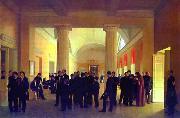 |
Sergey Zaryanko -- Click Here
|
|
Sergey Konstantinovich Zaryanko (1818 - 1871) was a Russian painter, he was as a pupil of Venetzianov |
|
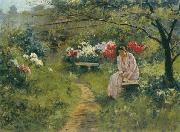 |
Sergey Ivanovich Svetoslavsky -- Click Here
|
|
painted In the Garden in 1900s
|
|
|
|
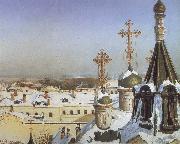 |
Sergei Svetoslavsky -- Click Here
|
|
Russia,1869-1938 |
|
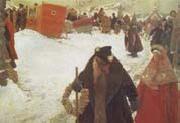 |
Sergei Ivanov -- Click Here
|
|
Russian Painter and Printmaker, 1864-1910 |
|
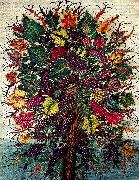 |
seraphine -- Click Here
|
|
Seraphine Louis, known as "Seraphine de Senlis" ("Seraphine of Senlis") (1864?C1942), was a French painter in the naïve style. Self-taught, she was inspired by her religious faith and by stained-glass church windows and other religious art. The intensity of her images, both in color and in replicative designs, are sometimes interpreted as a reflection of her own psyche, walking a tightrope between ecstasy and mental illness. |
|
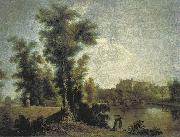 |
Semyon Shchedrin -- Click Here
|
|
(1745-1804) was a Russian landscape painter, the uncle and mentor of Sylvester Shchedrin.
He was born in St. Petersburg into the family of a life guard. In 1759, he entered the Academy of Arts in St. Petersburg, and in 1765 graduated with a gold medal and grants to study abroad. Shchedrin ventured to Paris, then to Rome. In Paris he studied the works of old and contemporary painters. Under the influence of Rousseau's idea that beauty exists not only in classic patterns of arts but also in everyday life and nature, Shchedrin worked much en plein-air, otherwise known as painting in outdoor environments. In Rome, however, he fell under the influence of classicism, the idea that art should reflect the works of antiquity and thus prolong their successes.
Shchedrin returned to St. Petersburg in 1776 and became a professor of landscape painting in the Academy of Arts. He was assigned to draw views of the palaces and parks of Catherine the Great, which brought into existence such works as View of the Large Pond Island in the Tsarskoselsky Gardens (1777), View of the Large Pond in the Tsarskoselsky Gardens (1777), View of the Farmyard in the Tsarskoye Selo (1777). After 1780, Shchedrin also participated in the restoration of pictures in the Hermitage, and in 1799 he headed a new class of landscape graphics.
The pinnacle of his art career came in the 1790s. The most famous of his works of the period are views of parks and palaces in Pavlovsk, Gatchina, and Petergof: The Mill and the Peel Tower at Pavlovsk (1792), View of the Gatchina Palace from the Silver Lake (1798), View of the Gatchina Palace from Long Island (1798), The Stone Bridge at Gatchina (1799-1801), View of the Kamennoostrovsky Palace through Bolshaya Nevka from the Stroganov Seashore (1803). The composition of all of his works is the same in accordance with the rules of academic classicism.
|
|
 |
Semyon Fyodorovich Shchedrin -- Click Here
|
|
(1745-1804) was a Russian landscape painter, the uncle and mentor of Sylvester Shchedrin.
He was born in St. Petersburg into the family of a life guard. In 1759, he entered the Academy of Arts in St. Petersburg, and in 1765 graduated with a gold medal and grants to study abroad. Shchedrin ventured to Paris, then to Rome. In Paris he studied the works of old and contemporary painters. Under the influence of Rousseau's idea that beauty exists not only in classic patterns of arts but also in everyday life and nature, Shchedrin worked much en plein-air, otherwise known as painting in outdoor environments. In Rome, however, he fell under the influence of classicism, the idea that art should reflect the works of antiquity and thus prolong their successes.
Shchedrin returned to St. Petersburg in 1776 and became a professor of landscape painting in the Academy of Arts. He was assigned to draw views of the palaces and parks of Catherine the Great, which brought into existence such works as View of the Large Pond Island in the Tsarskoselsky Gardens (1777), View of the Large Pond in the Tsarskoselsky Gardens (1777), View of the Farmyard in the Tsarskoye Selo (1777). After 1780, Shchedrin also participated in the restoration of pictures in the Hermitage, and in 1799 he headed a new class of landscape graphics.
The pinnacle of his art career came in the 1790s. The most famous of his works of the period are views of parks and palaces in Pavlovsk, Gatchina, and Petergof: The Mill and the Peel Tower at Pavlovsk (1792), View of the Gatchina Palace from the Silver Lake (1798), View of the Gatchina Palace from Long Island (1798), The Stone Bridge at Gatchina (1799-1801), View of the Kamennoostrovsky Palace through Bolshaya Nevka from the Stroganov Seashore (1803). |
|
 |
SEISENEGGER, Jacob -- Click Here
|
|
Austrian Painter, ca.1504-1567 |
|
 |
SEGHERS, Hercules -- Click Here
|
|
Dutch Baroque Era Painter and Printmaker, ca.1590-1638
Dutch landscape painter and etcher. Seghers's work greatly influenced early 17th-century Dutch landscape painting. He studied with the painter Coninxloo (1544C1607) and may have traveled to Italy and in the Alps. Some of the frenzy of his personal life can be seen in his rare paintings and his more numerous, masterly etchings. His landscapes consist of vast, often desolate, panoramas and powerful, smaller scenes rendered with drama and pathos. Rembrandt owned eight paintings by him, and his own landscape style was influenced by Seghers. |
|
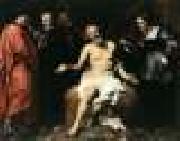 |
SEGHERS, Gerard -- Click Here
|
|
Flemish Baroque Era Painter, 1591-1651
Flemish painter, dealer and collector, active also in Italy and Spain. He grew up in Antwerp, a city that had only recently been liberated from the rebels by the Spanish troops. His father, a keeper of a wine tavern, originally had Calvinist sympathies but returned to the Catholic faith after 1585. Gerard possibly trained, as did afterwards his younger brother Jan Baptist Seghers, who later became a goldsmith, with Gaspar de Crayer (b 1551), the father of the well-known painter of the same name. At the age of 12 Seghers was listed as a pupil in the Guild of St Luke in Antwerp; the documents, unfortunately, fail to mention the name of his teacher. Florent Le Comte (1699) called him a pupil of Abraham Janssen |
|
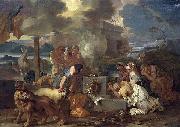 |
Sebastien Bourdon -- Click Here
|
|
(2 February 1616 - 8 May 1671) was a French painter and engraver. His chef d'œuvre is The Crucifixion of St. Peter made for the church of Notre Dame.
The Finding of Moses, c. 1650 (National Gallery of Art, Washington)Bourdon was born in Montpellier, France, the son of a Protestant painter on glass. He was apprenticed to a painter in Paris. In spite of his poverty he managed to get to Rome in 1636; there he studied the paintings of Nicolas Poussin, Claude Lorrain and Caravaggio among his eclectic selection of models, until he was forced to flee in 1638, to escape denunciation by the Inquisition for his Protestant faith. Bourdon's facility rendered him adept at portraiture, whether in a dashing Rubens manner or in intimate, sympathetic bust-length or half-length portraits isolated against plain backgrounds that set a formula for middle-class portraiture for the rest of the century, landscapes in the manner of Gaspar Dughet or cappricci of ruins, mythological "history painting" like other members of Poussin's circle or the genre subjects of the Dutch Bamboccianti who were working in Rome. His eclectic range of styles have given art historians exercise in tracing his adaptation of his models, while the lack of an immediately recognizable "Bourdon style" has somewhat dampened public appreciation.
In 1652 Christina of Sweden made him her first court painter. Bourdon spent most of his working career outside France, where, though he was a founding member of the Academie de peinture et de sculpture (1648), he was for long largely dismissed as a pasticheur, a situation partly rebalanced by a comprehensive exhibition in 2000 of his work at the Musee Fabre, where the collection includes a fine Lamentation painted in the last years of his life.
His success required the establishment of an extensive atelier, where, among his other pupils worked Nicolas-Pierre Loir and Pierre Mosnier. He died in Paris in 1671. |
|
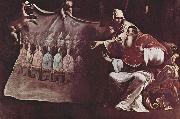 |
Sebastiano Ricci -- Click Here
|
|
(1 August 1659 - 15 May 1734) was an Italian painter of the late Baroque school of Venice. About the same age as Piazzetta, and an elder contemporary of Tiepolo, he represents a late version of the vigorous and luminous Cortonesque style of grand manner fresco painting.
He was born in Belluno, son of Andreana and Livio Ricci. In 1671, he apprenticed to Federico Cerebri of Venice. Others claim Ricci's first master was Sebastiano Mazzoni. In 1678, a youthful indiscretion led to an unwanted pregnancy, and ultimately to a greater scandal, when Ricci was accused of attempting to poison the young pregnant woman to avoid marriage. Imprisoned, he gained release only after intervention of a nobleman, probably a Pisani family member. He married the pregnant mother in 1691, although this was a stormy union.
After his arrest, he moved to Bologna, where he domiciled near the Parish of San Michele del Mercato. His painting style there was apparently influenced by Giovanni Gioseffo dal Sole. On 28 September 1682 he was contracted by the "Fraternity of Saint John of Florence" to paint a Decapitation of John the Baptist for their Oratory. On 9 December 1685, the Count of San Segundo near Parma commissioned from Ricci the decoration of the Oratory of the Madonna of the Seraglio, which he completed in collaboration of Ferdinando Galli-Bibiena by October 1687, receiving a compensation of 4,482 Lira. |
|
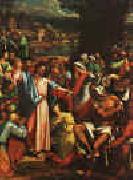 |
Sebastiano del Piombo -- Click Here
|
|
1485-1547 Italian Sebastiano del Piombo Galleries
Italian painter. He was one of the most important artists in Italy in the first half of the 16th century, active in Venice and Rome. His early, Venetian, paintings are reminiscent of Giovanni Bellini and to a lesser extent of Giorgione. With his move to Rome in 1511 he came under the influence of Raphael and then of Michelangelo, who supplied him with drawings. After the death of Raphael (1520) he was the leading painter working in Rome and was particularly noted as a portrait painter. In his finest works, such as the Piete (1513; Viterbo, Mus. Civ.) and the Flagellation (1516-24; Rome, S Pietro in Montorio), there is a remarkable fusion of the Venetian use of colour and the grand manner of central Italian classicism. |
|
 |
Sebastiano Conca -- Click Here
|
|
Italian Baroque Era Painter , 1680-1764
was an Italian painter. He was born at Gaeta, then part of the Kingdom of Naples, and apprenticed in Naples under Francesco Solimena. In 1706, along with his brother Giovanni, who acted as his assistant, he settled at Rome, where for several years he worked in chalk only, to improve his drawing. He was patronized by the Cardinal Ottoboni, who introduced him to Clement XI, who commissioned a well-received Jeremiah painted for the church of St. John Lateran. Conca was knighted by the pope. He collaborated with Carlo Maratta in the Coronation of Santa Cecilia in the namesake's church of Santa Cecilia in Trastevere (1721-24). He was elected in 1718 to the Accademia di San Luca and its director in 1729-1731 and 1739-1741. His painting was strongly influenced by the Baroque painter Luca Giordano. Among Conca's pupils were Pompeo Battoni, Andrea Casali, Placido Campoli, Corrado Giaquinto, Gaetano Lapis, Salvatore Monosilio, Literio Paladini, Drancesco Preziao, Rosalba Maria Salvioni, Gasparo Serenari, and Agostino Masucci, He received widespread official acclaim and patronage. He worked for a time for the Savoy family in Turin on the Oratory of San Filippo and Santa Teresa, in the Venaria (1721-1725), for Basilica di Superga (1726), and Royal Palace (1733). He painted frescoes of Probatica, or Pool of Siloam, in the Ospedale di Santa Maria della Scala (hospital) of Siena. In Genoa, he painted large allegorical canvases of the Palazzo Lomellini-Doria (1738-1740). In 1739, he published a guide to painting: Ammonimenti (or Admonishments), which blended moralistic advice with technique. He returned to Naples in 1752, and enjoyed the royal patronage of Charles III. |
|
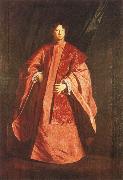 |
Sebastiano Bombelli -- Click Here
|
|
Italian, 1635-1719, Italian painter. He was perhaps the most influential Italian portrait painter of the later 17th century. His early style was formed by his father, Valentino Bombelli, a painter in Udine, and his godfather, the Mannerist artist Girolamo Lugaro. In the early 1660s he was in Venice (Boschini; Sansovino), where he responded passionately to the brilliant colour, painterly freedom and naturalism of 16th-century Venetian artists, particularly Veronese |
|
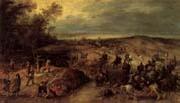 |
Sebastian Vrancx -- Click Here
|
|
Flemish Baroque Era Painter ,
b. 1573, Antwerpen, d. 1647, Antwerpen
Antwerpen,was a Flemish Baroque painter and etcher of the Antwerp school. He was an apprentice in the workshop of Adam van Noort, who also trained many illustrious painters such as Peter Paul Rubens, Jacob Jordaens and Hendrik van Balen. He also visited the workshop of the Antwerp painter Paul Bril in Rome around 1600. He was esteemed as one of the main painters of battle scenes, and works by Vrancx were in the collection of Peter Paul Rubens. As a collaborator he worked at times with Jan Brueghel the Elder. and together with Rubens, Frans Francken the Younger, van Balen, Frans Snyders and Joos de Momper the Younger on the Allegory of the Senses, two works commissioned on the occasion of the archduke Albert of Austria's visit to Antwerp. His best-known student is Pieter Snayers. Most of his pictures represent biblical scenes or scenes of war, such as the sack of towns, cavalry combats, genre paintings and allegorical subjects. Though occasionally vigorous in drawing, his paintings are dull and heavy in tone. He was at the same time a writer of poetry, comedies and tragicomedies for the chamber of rhetoric De Violieren. He was served as dean of the Antwerp painters' Guild of St. Luke, and was a district head and captain of the militia. His works can be found in the Royal Museum of Fine Arts in Antwerp, |
|
|
|
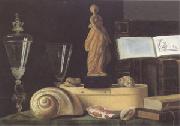 |
Sebastian Stoskopff -- Click Here
|
|
Strasbourg 1597-Idstein 1657
was an Alsatian painter. He is considered one of the most important German still life painters of his time. His works, which were rediscovered after 1930, portray goblets, cups and especially glasses. The reduction to a few objects, which is characteristic of early still life painting, can again be recognized in Stoskopff's painting. His chief works hang in Strasbourg and in Saarbr??cken. Sebastian Stoskopff was born in 1597 in Strasbourg. His father was employed by the city since 1590 and acted as a mounted courier or royal escort, driving a one-horse-carriage. In 1614, Stoskopff's father asked the Strasbourg council for help for his 17-year-old son. He wanted him to be able to learn the craft of painting, since Sebastian had already been extremely talented in drawing and painting since he was 15. The council agreed to provide their support and probably sent the young artist at first to the Strasbourg painter and copper engraver, Friedrich Brentel. However, he only learned how to further refine his drawing and was not, as hoped, introduced to the art of painting. In 1615, Stoskopff's father died and his widowed mother went to the Strasbourg council once again to ask for support for training from a recognized painter. Stoskopff was then sent to Daniel Soreau, a painter who was active in Hanau. In the beginning, Soreau was not very enthusiastic, since he usually chose his apprentices from among his relatives and close friends. However, he finally complied with the request of the council and assured them that would "make an Albrecht Derer of this apprentice". There is not a single definite picture by Daniel Soreau existing. It is only possible to draw conclusions about how well the master passed on his artistic skills to his students through the works of his sons, other apprentices of his workshop and through Stoskopff's works. After Soreau's death in 1619, Stoskopff took over his workshop with the apprentices, as well as his function as the master. One of the apprentices was Joachim von Sandrart, who later became a successful painter and who wrote the first important work on the history of art in the German language: "Teutsche Academie der Bau-, Bild,- und Malerey- Kenste". This work contains descriptions of the lives of earlier and contemporary artists, including descriptions of the time in Hanau with his master, Sebastian Stoskopff. After his attempt to get permission to settle in Frankfurt failed, Stoskopff went to Paris. He stayed there from about 1622 until 1639, which can be reconstructed from indirect reports and property inventories of Parisians. His first works in larger format were also created here, such as "Summer" or "Winter" (now both in Strasbourg). |
|
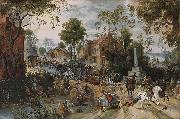 |
Sebastiaen Vrancx -- Click Here
|
|
(22 January 1573 - 19 May 1647) was a Flemish Baroque painter and etcher of the Antwerp school.
He was an apprentice in the workshop of Adam van Noort, who also trained many illustrious painters such as Peter Paul Rubens, Jacob Jordaens and Hendrik van Balen. He also visited the workshop of the Antwerp painter Paul Bril in Rome around 1600.
He was esteemed as one of the main painters of battle scenes, and works by Vranckx were in the collection of Peter Paul Rubens. As a collaborator he worked at times with Jan Brueghel the Elder. and together with Rubens, Frans Francken the Younger, van Balen, Frans Snyders and Joos de Momper the Younger on the Allegory of the Senses, two works commissioned on the occasion of the archduke Albert of Austria's visit to Antwerp. His best-known student is Pieter Snayers.
Most of his pictures represent biblical scenes or scenes of war, such as the sack of towns, cavalry combats, genre paintings and allegorical subjects. Though occasionally vigorous in drawing, his paintings are dull and heavy in tone.
He was at the same time a writer of poetry, comedies and tragicomedies for the chamber of rhetoric De Violieren. He was served as dean of the Antwerp painters' Guild of St. Luke, and was a district head and captain of the militia.
His works can be found in the Royal Museum of Fine Arts in Antwerp, Groeninge Museum in Bruges (both in Belgium) and the Noordbrabants museum in 's-Hertogenbosch and the Rijksmuseum in Amsterdam (the Netherlands). He is also represented with several drawings or paintings at the Hermitage in Saint Petersburg, the Harvard University Art Museums, the Louvre, Paris and several other museums.
|
|
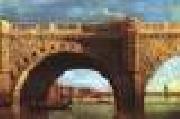 |
SCOTT, Samuel -- Click Here
|
|
English Painter, ca.1702-1772
English painter. In 1725 a sea-piece ascribed to Scott appeared at auction in London. In 1727 he was appointed Accomptant in the Stamp Office, Lincoln's Inn Square, London. |
|
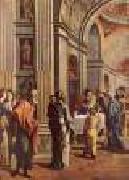 |
SCOREL, Jan van -- Click Here
|
|
Dutch Northern Renaissance Painter, 1495-1562
North Netherlandish painter and ecclesiastic. He was one of the first north Netherlandish artists to visit Italy, and his return to Utrecht in 1524 can be regarded as a turning-point in the history of painting in the northern Netherlands. The important role Scorel played in introducing Italian art in the north was recognized even by contemporary writers and was reiterated slightly later by van Mander |
|
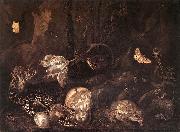 |
SCHRIECK, Otto Marseus van -- Click Here
|
|
Dutch Baroque Era Painter, 1619-1678
Dutch painter. According to Houbraken, he travelled to Italy and stayed in Rome and Florence with the painters Matthias Withoos and Willem van Aelst, the latter his pupil at the time. Among his patrons were Ferdinando II de' Medici, Grand Duke of Tuscany (reg 1621-70). Van Hoogstraten claimed that he met van Schrieck in Rome as late as 1652. In Rome, van Schrieck was a member of the Schildersbent. About 1657 he returned with van Aelst to Amsterdam, where he had a small property and got married on 25 April 1664. An inventory of the contents of his house was made in July 1678, shortly after his death, in which more than 300 paintings are listed. Besides his own paintings, there were works by Cornelis van Poelenburch, Simon de Vlieger, Ludolf Bakhuizen, Jan Wijnants, Lucas van Leyden |
|
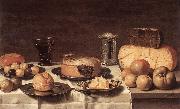 |
SCHOOTEN, Floris Gerritsz. van -- Click Here
|
|
Dutch painter (b. ca. 1590, Haarlem, d. after 1655, Haarlem) |
|
 |
School of Latium -- Click Here
|
|
First half of the thirteenth century |
|
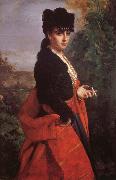 |
Schlesinger Henri Guillaume -- Click Here
|
|
French portraits and genre painter , 1846-1884
|
|
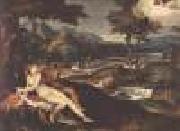 |
SCHIAVONE, Andrea -- Click Here
|
|
Italian Painter, ca.1500-1563 |
|
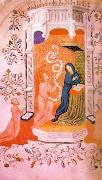 |
SCHEERE, Herman -- Click Here
|
|
German miniaturist ,
active 1403-1419 in England |
|
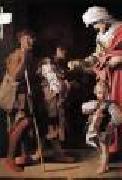 |
SCHEDONI, Bartolomeo -- Click Here
|
|
Italian painter, Emilian school (b. 1578, Modena, d. 1615, Parma)
Italian painter and draughtsman. He was the son of Giulio Schedoni, a mask-maker, who served the Este court in Modena and the Farnese in Parma; in 1598 Schedoni and his father are recorded as residing in Parma, both serving the court. In 1595 Ranuccio I, Duke of Parma, sent Bartolomeo to Rome, to train in the studio of Federico Zuccaro. Schedoni fell ill shortly after, however, and returned to Parma. His earliest surviving works show no evidence of Roman influence. The matter of Schedoni's training remains somewhat problematic. Carlo Cesare Malvasia claimed that he was a pupil of Annibale Carracci in Bologna, but there are reasons to doubt this. First, this would have been prior to Annibale's departure for Rome in 1595, a period when Schedoni was still apparently under his father's jurisdiction. Secondly, the early pictures indicate that initially his style was formed primarily by studying the work of Correggio in Parma. To a lesser degree he was influenced by the Parmesan culture of Parmigianino, Girolamo Mazzola Bedoli and Michelangelo Anselmi. As a boy in Parma he was also known to have frequented the studio of the Fleming Giovanni Sons (1547/8-1611). |
|
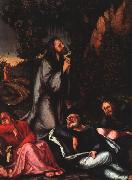 |
SCHAUFELEIN, Hans Leonhard -- Click Here
|
|
German Northern Renaissance Painter, ca.1480-1540
was a German painter, designer, and wood engraver. He was born in Nuremberg, probably studied under Wohlgemut, and then became the assistant of D??rer, whom he imitated. In 1512 he went to Augsburg and in 1515 removed to Nordlingen. He is a graceful narrator, and his types, though rarely accurately drawn, are attractive, but he lacks power and depth. Characteristic early paintings are the altarpiece at Ober Sankt Veit[1], near Vienna (1502), "Scenes from the Life of Christ" (Dresden Gallery), and "St. Jerome" (Germanic Museum, Nuremberg). To his Nordlingen period belong his masterpiece, the so-called "Ziegler Altar" for St. George's Church (1521), part of which is still in the church, part in the museum; "Scenes from the Story of Judith," in the town hall; and the illuminated Psalter for Count von Ottingen, now in the Berlin print room. His most important woodcuts are those for the Theuerdank of Emperor Maximilian. |
|
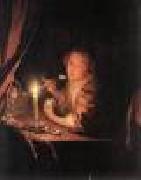 |
SCHALCKEN, Godfried -- Click Here
|
|
Dutch Baroque Era Painter, 1643-1706
Dutch painter and etcher, active also in England. He was the second son of Cornelis Schalcken from Heusden, a clergyman in Made, and Aletta Lydius, who came from a famous clerical family in Dordrecht. In 1654 the family moved to Dordrecht, where Cornelis was appointed headmaster of the Latin school. There Godfried was apprenticed to Samuel van Hoogstraten. He completed his training in Leiden with Gerrit Dou and by 1665 had returned to Dordrecht. Schalcken's earliest known works, for example the Doctor's Visit (1669; Germany, priv. col., on loan to Cologne, Wallraf-Richartz-Mus.), are dominated by the influence of Dou and the Leiden 'fine painters'. Like Dou, Schalcken painted small genre pieces with a wealth of painstakingly rendered detail, and his themes and frequent use of artificial lighting are strongly reminiscent of the Leiden master. The six prints known by him, including a portrait of Gerrit Dou and a few portraits after van Hoogstraten, must also originate from this period. Possibly under the influence of Caspar Netscher and Frans van Mieris, Schalcken soon afterwards adopted a freer touch with gentler transitions and a lighter palette and applied himself to painting genre pieces with elegant figures. |
|
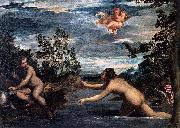 |
Scarsellino -- Click Here
|
|
(1550 (or 1551) - 1620), was an Italian Late-Renaissance - Mannerist painter of the School of Ferrara. He was born and died in Ferrara; however, he traveled and worked extensively across Italy, encountering many influences. He was born to an artist father, the less-talented Sigismondo Scarsella. Apparently he lived in Venice for 4 years around 1570, though it is not known if he was affiliated to a particular studio. His early works show the influences of various contemporary styles and painters including the venetian schools and locally Dosso Dossi.
A number of his works now are at the Galleria Borghese in Rome, The Bathing Venus, Diana and Endymion and Venus and Adonis. Scarsellino worked alongside the brothers Carracci in the Palazzo dei Diamanti in Ferrara. However, unlike the Carracci, Scarsellino's paintings have a decorative quality, and lack monumentality. World War II bombing of Dresden destroyed two of his paintings: Flight into Egypt and Holy Family at Work.
|
|
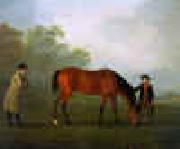 |
Sawrey Gilpin -- Click Here
|
|
1733-1807
English
Sawrey Gilpin Gallery
Gilpin was born 30 Oct 1733 in Cumbria, the son Captain John Bernard Gilpin, a soldier and amateur artist. His elder brother William Gilpin was a clergyman, schoolmaster, and author of several influential works on picturesque scenery.
Apprenticed to the marine painter Samuel Scott of Covent Garden, Sawrey came to specialise in painting animals, particularly horses and dogs, which he sometimes added to backgrounds by other artists, including Philip Reinagle, George Barret and J. M. W. Turner. He was patronised by Prince William Augustus, Duke of Cumberland. Gilpin was Director and President of the Society of Artists, and a member of the Royal Academy from 1796.
Sawrey Gilpin married Elizabeth Broom; their son William Sawrey Gilpin also became an artist, and in later life a landscape gardener.
He died at Broughton, Northamptonshire, England in 1807.
Works by Sawrey Gilpin are in the collections of the Courtauld Institute of Art , Tate Britain [3], and the Royal Academy in London and the Fitzwilliam Museum, Cambridge. |
|
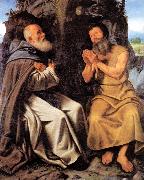 |
SAVOLDO, Giovanni Girolamo -- Click Here
|
|
Italian Mannerist Painter, ca.1480-1548 |
|
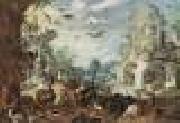 |
SAVERY, Roelandt -- Click Here
|
|
Flemish Northern Renaissance Painter, 1576-1639
Flemish Northern Renaissance Painter, 1576-1639.Painter, draughtsman and etcher, brother of (1) Jacob Savery I. The subject and miniaturist precision of his earliest dated work, Birds by a Pond (1600; St Petersburg, Hermitage), reflect the influence of Jacob, his presumed teacher. The strong Flemish current in Amsterdam c. 1600 is apparent in the Village Edge |
|
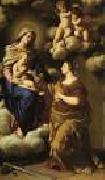 |
SASSOFERRATO -- Click Here
|
|
Italian Baroque Era Painter, 1609-1685
Italian painter and draughtsman. He served his apprenticeship under his father, Tarquinio Salvi. Tradition has it that he later (it is not known exactly when) studied with Domenichino in Naples, where he certainly had the opportunity of meeting Francesco Cozza and where he painted the Adoration of the Shepherds (Naples, Capodimonte). As a young man, Sassoferrato probably travelled often in the areas bordering on the Marches, for example in Umbria and particularly Perugia, where from 1630 he was connected with the Benedictine convent of S Pietro, for which he painted canvases of ten saints for the ceiling of the sacristy of the convent church
|
|
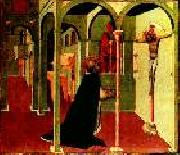 |
SASSETTA -- Click Here
|
|
Italian Early Renaissance Painter, ca.1390-1450 |
|
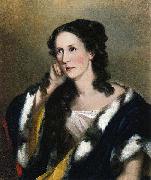 |
Sarah Miriam Peale -- Click Here
|
|
(Philadelphia, Pennsylvania, May 19, 1800 - February 4, 1885, Philadelphia) was an American portrait painter, one of the notable family of artists descended from the miniaturist and still-life painter James Peale, who was her father. She is noted as a portrait painter, mainly of politicians and military figures. Lafayette sat for her four times.
Sarah was James Peale's youngest daughter and was trained by her father, and uncle Charles Willson Peale. She served as a studio assistant to her father. Her first public works date from 1816 with subjects such as flowers and still-life but soon turned to portraiture, In 1818, she spent three months with Rembrandt Peale, her cousin, in Baltimore, and again in 1820 and 1822. He influenced her painting style and subject matter. For 25 years, she painted in Baltimore (1822-47) and, intermittently, in Washington, D.C.
She was accepted to the Pennsylvania Academy of Fine Arts in 1824 along with her sister Anna Claypoole Peale, the first women to achieve this distinction. Over 100 commissioned portrait paintings are known from her time in Baltimore and she was the most prolific artist in the city during that era. Her subjects were wealthy Baltimore residents and politicians from Washington DC. |
|
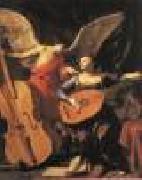 |
SARACENI, Carlo -- Click Here
|
|
Italian painter, Roman school (b. 1579, Venezia, d. 1620, Venezia). Italian painter. He is best known for his jewel-like paintings representing sacred and secular themes, which combine a delicate technique inspired by Adam Elsheimer with a note of observed realism owed to Caravaggio. He also painted altarpieces and worked in fresco. |
|
|
|
|
| | |
|
|
|
|